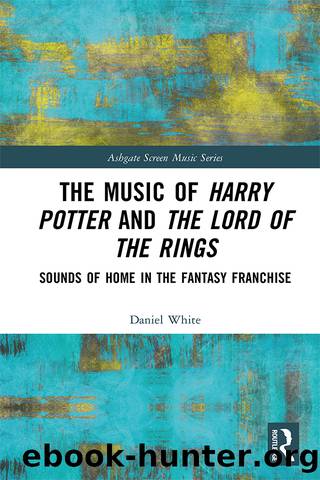The Music of Harry Potter and The Lord of the Rings by Daniel White;

Author:Daniel White;
Language: eng
Format: epub
Publisher: Taylor & Francis (Unlimited)
Published: 2024-07-15T00:00:00+00:00
The Wizarding Community - An Imagined, Audible Homeland
Sean Carter and Klaus Dodds note that the notion of âhomelandâ features frequently in war/action films as something to be defended, protected or liberated; âa safe national space in which citizens can feel safe and secure from the realities of an anarchic worldâ (2014, p. 98). Their concept of an âimagined homelandâ is quite applicable here: not only is the wizarding world imaginary in the literal sense (and thus reliant on the engaged imagination of the subject), it also requires some willing imagination from the filmic characters who inhabit it, it not being geographically demarcated but indeed delineated by the magical characteristics of its inhabitants. The wizarding world could be framed as more of a âconstellated communityâ than a homeland, and yet the existence of wholly magical locales (Diagon Alley, Hogsmeade, Platform 9¾, Hogwarts, 12 Grimmauld Place, Godricâs Hollow), segregated by the sole presence of magical folk and hidden by protective charms and enchantments, argues the case for a more tangible, situated homeland. Though witches and wizards coexist with non-magical people (âmugglesâ), these are places where the magical way of life is the norm, safe spaces for the practising of magic by a people who effectively live in hiding: a form of self-imposed exile, described by Katherine Fowkes as a âsystem of apartheidâ (2010, p. 163). Thus, the wizarding âhomelandâ that welcomes Harry with open arms can be seen to comprise both the network of magical homes and spaces and the magical folk who inhabit them.
An investigation into the musical portrayal of the wizarding community gives extra depth and understanding to the sense of homeliness that fills the filmsâ magical spaces and also acts as a strong impetus for both the filmsâ action and the viewerâs continued return to the fantasy world in filmic/ non-filmic contexts. The aforementioned wizarding places are often depicted as requiring some form of magical transition in order to gain access to them, such as running âthroughâ a train station wall or tapping certain bricks in the back of an old pub, acting in a similar way to Jonathan Grayâs âairlockâ (see Chapter 1) by enabling the transition from non-magical to magical space. These transitions (in which music plays a strong role just as in the opening and closing sequences) can be further defined as âhomecomingsâ in the sense that they transport Harry (and the viewer) from muggle to wizard territory, from foreign land to homeland, from exile to return, and indeed from the mundane to the wondrous.
Philosopherâs Stone documents the beginning of Harryâs exile from the wizarding world, being trusted to the care of his non-magical aunt and uncle after the death of both his parents, as well as his return to it at the age of eleven. As noted by Jamie Lynn Webster (2012), the magical and non-magical worlds are musically demarcated by the presence or absence of non-diegetic music: magical events and locations are treated to heavy orchestral underscoring, and muggle locations such as the Dursleysâ house are notably depicted in non-diegetic silence (with no underscore).
Download
This site does not store any files on its server. We only index and link to content provided by other sites. Please contact the content providers to delete copyright contents if any and email us, we'll remove relevant links or contents immediately.
| Biographies | Business |
| History & Criticism | Instruments |
| Musical Genres | Recording & Sound |
| Reference | Songbooks |
| Theory, Composition & Performance |
The Goal (Off-Campus #4) by Elle Kennedy(13199)
Kathy Andrews Collection by Kathy Andrews(11325)
Diary of a Player by Brad Paisley(7267)
What Does This Button Do? by Bruce Dickinson(5932)
Assassin’s Fate by Robin Hobb(5855)
Big Little Lies by Liane Moriarty(5513)
Altered Sensations by David Pantalony(4867)
Pale Blue Dot by Carl Sagan(4618)
Sticky Fingers by Joe Hagan(3912)
The Death of the Heart by Elizabeth Bowen(3340)
The Heroin Diaries by Nikki Sixx(3320)
Beneath These Shadows by Meghan March(3149)
Confessions of a Video Vixen by Karrine Steffans(3100)
The Help by Kathryn Stockett(3018)
How Music Works by David Byrne(2964)
Jam by Jam (epub)(2876)
Harry Potter 4 - Harry Potter and The Goblet of Fire by J.K.Rowling(2801)
Strange Fascination: David Bowie: The Definitive Story by David Buckley(2701)
Petty: The Biography by Warren Zanes(2574)
